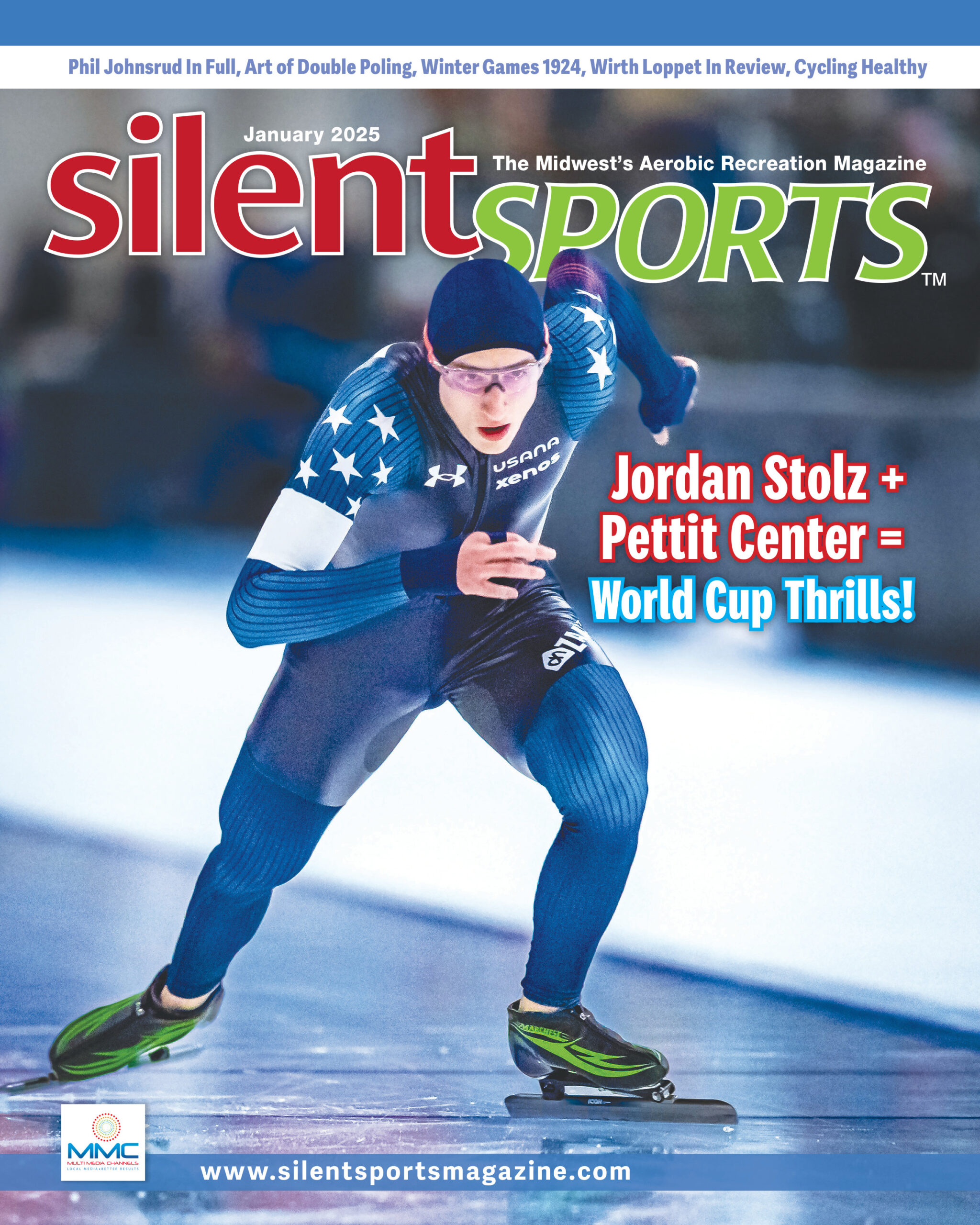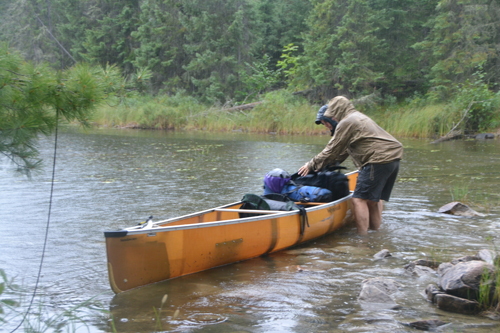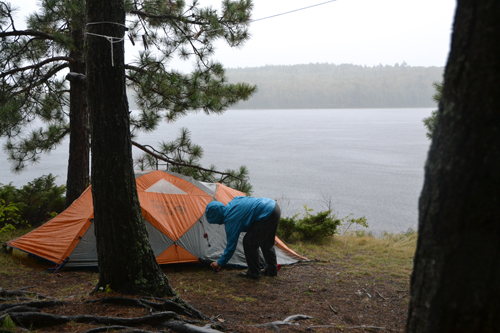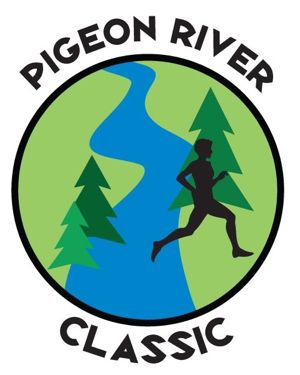Staying Dry – Dressing for success on rainy days
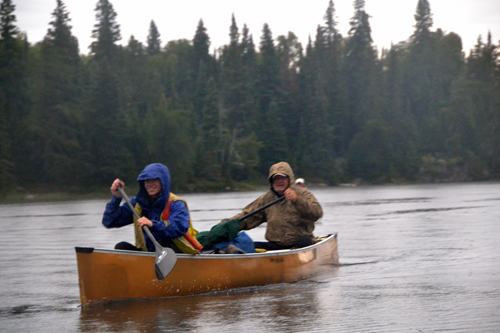
By Dave Foley
It was 1979 and I was in Hopkinton, Massachusetts, waiting along with about 6,000 others for the start of the Boston Marathon. (Yes, the Boston Marathon wasn’t always a mega-size race). Then a cold drizzle began to fall. A T-shirt and shorts was not going to be fun. At that point, I produced a cheap dollar rain poncho and pulled it over me. Problem solved. After suffering through some near hypothermic experiences on camping trips, I have learned the value of having raingear handy whenever there’s a possibility of precipitation.
Getting wet for a few minutes before running a marathon may be uncomfortable, but trying to cope with rain without adequate protection on a backcountry outing can be dangerous. Most years, I am out on at least one extended canoe trip lasting over 10 days, where consecutive rainy days are likely. It’s not surprising that the most expensive clothing I own is my rainsuit. Whereas usually I’m the type of shopper that just grabs something off the rack and, if it fits, I buy it, with rain gear the stakes are higher. I can’t afford to have a “wardrobe malfunction.”
The winning jacket/pants combo for me is made with Gore-Tex, has a 100% nylon liner and sealed zippers. In checking out rain gear, look for roominess so you can add under layers for warmth. Make sure that your rain coat is long enough so you can sit without leaving a gap between your pant top and your jacket bottom.
The jacket/pant unit should be lightweight so it can be worn during summer storms. Look for Gore-Tex or other breathable fabrics. If your rain gear doesn’t breathe, the trapped heat creates a sauna-like effect, bathing you in sweat. Make sure the jacket has venting slits to provide air circulation. When portaging or being active, leave these vents open to keep you from heating up. If pockets are mesh, they will double as vents. Zippers and vents need to have flaps to repel moisture coming from the outside. Sleeves should have Velcro strips to secure them, and pants must be equipped with snaps, Velcro, or ties to keep water off the ankles.
The jacket has to have a hood with a tie, so that when in use the wind can’t blow it back. The best design positions the tie so a secured hood will turn with your head giving you some peripheral vision and eliminating the blinder effect.
For headgear, I prefer a baseball cap. The falling drops will land on the hat’s bill rather than my face. When it rains harder, I pull the hood up over my hat. My wife likes the Tilley hat with its wider brim.
Since my Quetico trips occur in May or September, I can expect at least a rainy day every week and those drops are likely to be cold. There may not be many T-shirt-and-shorts days, so I’m often wearing layers, most of them composed of quick-drying nylon fabrics with trade names like Polartec, Capilene, CoolMax, Mountain Hardware, Under Armour and Smart Wool. These synthetic fabrics not only wick moisture away from your skin, but they are fast-drying which is a plus when sunshine is a rare commodity. Although I may take a cotton T-shirt for sunny days, they are a poor choice for wearing in stormy weather. Cotton doesn’t wick away wetness; if it’s damp it just holds the moisture in, robbing you of body heat.
On our September trips, we usually do about 20 to 30 portages. When we’re traveling, keeping my feet dry is not a priority.
I wear running shoes and wool socks. Usually I buy a new pair of shoes just before we leave for the trip to give me the best traction. Around the campsite I wear another pair of running shoes or Keen sandals. If it’s raining, I continue to wear the shoes I use for traveling.
In the spring, I’m on a fishing trip where we base camp. Since we do little walking and only portage a couple times, I wear knee-high rubber boots. I find them too uncomfortable to do much portaging, but they keep my feet dry and I can jump out at landings before our Kevlar canoe grounds onto the shore.
Leather/Gore-Tex 10-inch-high insulated boots keep your feet dry in the water, provide good support for hiking and are comfortable. I would probably own a pair, except I’m afraid that in my zeal to get into the water before the canoe grounds, I would often enter water deeper than the top of the boot, soaking my foot. These boots are not fast-drying.
It may seem obvious that when it begins to rain, you should put on your rain gear. Yet so often as it begins to sprinkle, we procrastinate, thinking the shower will quickly pass. Even though you may be the smart one, who puts on rain gear as the first drops fall, make sure the others in your group take similar action, since typically if one person is wet and miserable it has an effect on everyone. While putting on rain gear may seem an obvious strategy for the cold rains of spring and fall, it is still sound advice in the summer.
Summer rains often feel good at first. A cool shower spraying you as you finish a grueling portage can feel downright refreshing. However, even on the hottest days you can get chilled, especially if you are sitting in a canoe or around the campsite. Once your clothes are wet, rain gear won’t be of much use and that damp fabric against your skin will soon lead to shivering.
Rain keeps our environment green, often stimulates the fish to bite, and can bring relief after a stretch of hot weather. If you’re dressed for inclement weather, stormy times needn’t curtail your activities, nor dampen you or your enthusiasm.

